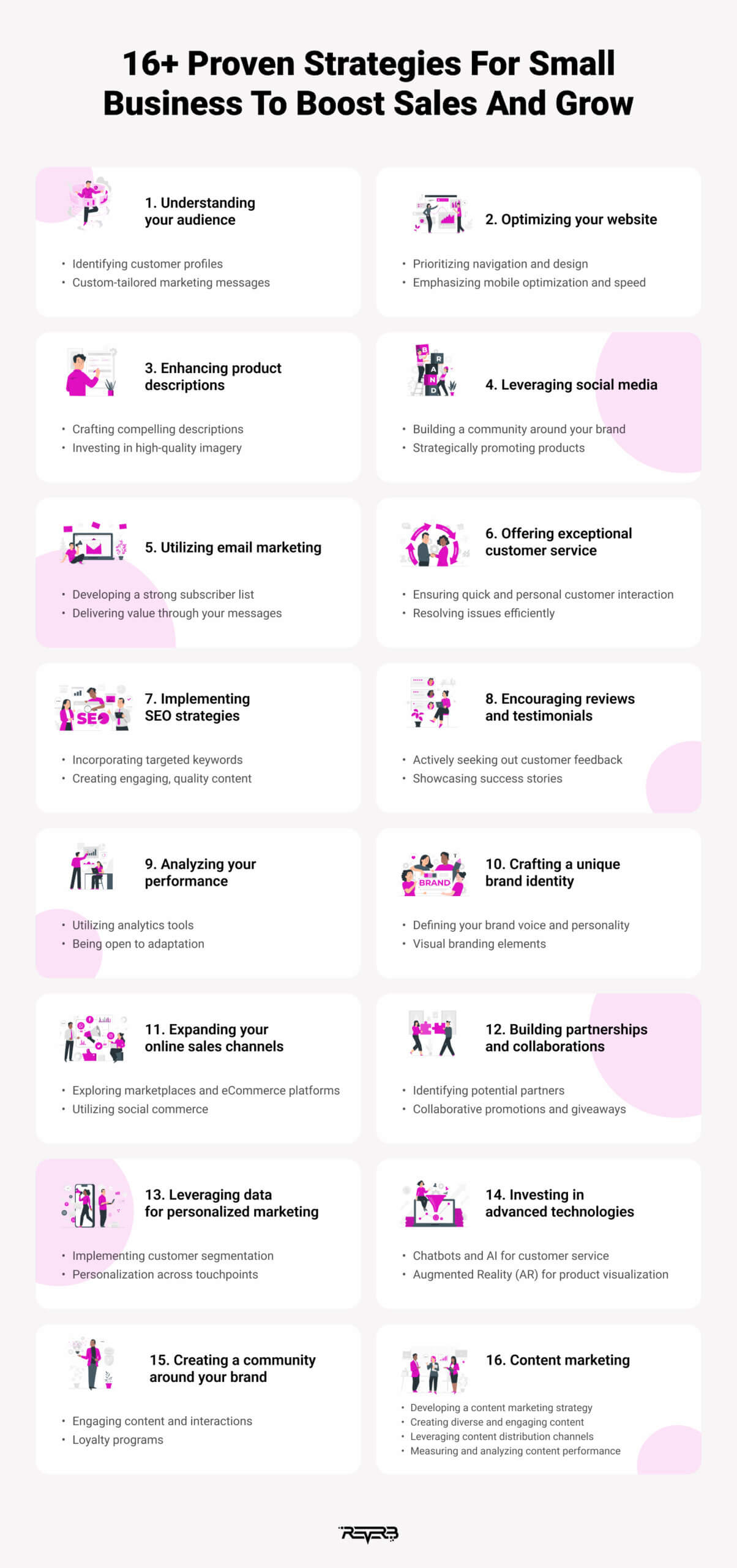Small businesses stand on the edge of unexplored opportunities that boost their online sales.
The shift towards digital shopping venues has opened up vast new horizons for small enterprises to explore and conquer.
Yet, this digitalization provides opportunities but also comes up with several challenges and provides high competition among all the newbie businesses. To ace these challenges and successfully boost sales, starter businesses must employ a strategic blend of innovation, customer insight, and holistic steps.
This blog aims to provide an arsenal of targeted strategies to shine in the business world and increase online visibility, customer engagement, and sales success.
Proven Strategies For Small Business To Boost Sales And Grow

1. Understanding your audience
Before going deeply into the digital marketing horizon, learning about your desired/targeted audience is paramount. Knowing who your customers are, what they desire, and how they interact online lays the groundwork for any successful marketing strategy. There are two key aspects to understanding your audience effectively:.
- Identifying customer profiles: Start with demographics Begin with broad strokes—age, location, gender— analysis of their searches. What are their hobbies? What challenges do they face? Such insights can inform more targeted marketing efforts.
- Custom-tailored marketing messages: Ozzy Akpek, CEO of Smile Art Design tells us to use surveys, social listening tools, and customer feedback to uncover psychographic information and refine your audience personas for more effective engagement and conversion. After analyzing all the key aspects, start approaching your audience through tailored marketing messages. This approach significantly enhances customer engagement and conversion rates.
2. Optimizing your website
Website is the pre-requisite for any business who wants to flourish in the online world and want to boost their sales. Adam Hardingham CEO of Rivmedia Another important thing is to make sure your website works well and is easy for search engines to find and understand.
This is like making your website stand out so it gets noticed more easily by people searching online. It is the first point of contact between your business and potential customers. A well-optimized, user-friendly website can be a powerful tool for converting visitors into loyal customers.
- Prioritizing navigation and design: A well-organized site with a clean, attractive design is appealing to the visitors so they start exploring. Similarly, easy and intuitive navigation allows users to easily explore the website a short pop-up suggestion is also useful.
- Emphasizing mobile optimization and speed: Another important focus point is mobile optimization – the technology shift now allows users to work entirely using their mobile phones. If your website is not mobile-friendly and cannot load pages on a mobile device, you face problems. A mobile-optimized site is essential. Additionally, a fast-loading site improves user experience and aids in search engine ranking.
3. Enhancing product descriptions
The way you present your products online can make a clear difference between you and your competitors. Detailed, engaging product descriptions paired with high-quality images can significantly influence buying decisions.
- Crafting compelling descriptions: Description is the first place where you meet your users. Focus on how it benefits the user. Use easy language that appeals to the senses and emotions.
- Investing in high-quality imagery: Many businesses do not focus on high-quality images, which leads to the backdrop of their business, among others. Product photography should be clear, well-lit, and showcase the item from multiple angles. Consider adding videos for a 360-degree view or showing the product in use.
4. Leveraging social media
Social media platforms are invaluable tools for connecting with your audience and promoting your products. They offer a space for two-way communication, allowing businesses to engage directly with potential and current customers.
- Building a community around your brand: Use social media not just for promotion but to create a sense of community. Share behind-the-scenes content, respond to comments, and participate in relevant conversations.
- Strategically promoting products: While engagement is key, social media is also a powerful platform for product promotion. Share updates about new products, special offers, and customer testimonials to drive interest and sales.
5. Utilizing email marketing
Email marketing is one of the most important strategies for reaching out to your audience/customers. It depends on effective execution; it can foster loyalty, encourage repeat business, and keep your brand in mind.
- Developing a strong subscriber list: Offer incentives for signing up to your mailing list, such as discounts or exclusive content. Make the signup process easy and accessible from your website and social media profiles.
- Delivering value through your messages: Your emails should offer real value to your subscribers, whether through informative content, insider news, or special deals. Personalization can further enhance the effectiveness of your email campaigns.
6. Offering exceptional customer service
Outstanding customer service can set your small business apart from the competition. In an online world, being readily available and responsive to your customer’s needs can significantly impact your reputation and sales.
- Ensuring quick and personal customer interaction: Implement live chat on your website and be active on social media channels. Personalize your responses to customer inquiries to build a connection and trust.
- Resolving issues efficiently: Develop a streamlined process for addressing customer complaints and issues. Show your customers that their satisfaction is your top priority.
7. Implementing SEO strategies
Search Engine Optimization (SEO) is crucial for improving your website’s visibility in search engine results. A higher ranking can lead to more website traffic and, ultimately, more sales.
- Incorporating targeted keywords: Conduct thorough research to identify keywords that are relevant to your products and audience. Integrate these keywords into your website’s content and meta tags.
- Creating engaging, quality content: Regularly update your site with fresh, relevant content that provides value to your audience. Blog posts, how-to guides, and product reviews can attract visitors and improve your site’s SEO.
According to Dmitriy Shelepin, a CEO and Head of SEO at Miromind, while optimizing your website, being patient and consistent is important. SEO takes time, and the rules change often. You have to keep improving your website and content to keep up with these changes. At Miromind, we stick with our clients for the long haul, helping them adapt and grow.
8. Encouraging reviews and testimonials
Positive reviews and testimonials can greatly influence potential customers’ purchasing decisions. Encouraging your satisfied customers to share their experiences can bolster your business’s credibility and attract new customers.
- Actively seeking out customer feedback: Make it easy for customers to leave reviews on your website and third-party platforms. Consider sending a follow-up email after a purchase, inviting customers to review their experience.
- Showcasing success stories: Feature customer testimonials prominently on your website and social media. Real-life stories of how your products or services have made a difference can be very persuasive.
9. Analyzing your performance
To continually refine and improve your strategies, it’s essential to analyze your performance. Understanding what works and what doesn’t allows you to make informed decisions and adapt your tactics accordingly.
- Utilizing analytics tools: Tools like Google Analytics provide insights into your website traffic, user behavior, and conversion rates. Use this data to identify trends, pinpoint successful strategies, and identify areas for improvement.
- Being open to adaptation: The digital landscape is always changing. Stay flexible and be willing to adjust your strategies based on performance data, customer feedback, and evolving market trends.
10. Crafting a unique brand identity
Establishing a unique brand identity is pivotal in setting your business apart in the digital realm. According to Holly Cooper, Marketing Manager at LUCAS PRODUCTS & SERVICES, a strong brand resonates with your target audience, builds loyalty, and enhances recognition.
- Defining your brand voice and personality: Your brand’s voice should reflect its personality and values, whether it’s professional, friendly, innovative, or quirky. Consistency across all channels strengthens your brand’s identity and fosters trust.
- Visual branding elements: Develop a cohesive visual identity that includes your logo, color scheme, typography, and imagery style. These elements should be consistently used across your website, social media, and marketing materials to enhance brand recall.
11. Expanding your online sales channels
Relying solely on your website for online sales can limit your reach. Expanding your presence across multiple online sales channels can tap into new audiences and increase revenue streams.
- Exploring marketplaces and eCommerce platforms: Beyond your website, consider selling on popular eCommerce platforms and marketplaces like Amazon, Etsy, or eBay. Each platform offers access to a vast audience and comes with its set of tools and rules for sellers.
- Utilizing social commerce: Platforms like Instagram and Facebook offer shopping features that allow businesses to sell directly through their social media profiles. These tools make it easy for users to discover and purchase products without leaving the app.
12. Building partnerships and collaborations
Ben Flynn, Marketing Manager at 88Vape, believes that collaborating with other businesses or influencers can introduce your brand to new audiences and add credibility to your offerings.
- Identifying potential partners: Look for businesses or influencers with audiences that overlap with your target market but aren’t direct competitors. These partnerships can be mutually beneficial in reaching a wider audience.
- Collaborative promotions and giveaways: Collaborate on promotions, giveaways, or co-branded products. These initiatives can generate excitement, enhance engagement, and increase visibility for both parties.
13. Leveraging data for personalized marketing
In the age of information, leveraging customer data to offer personalized experiences can significantly boost engagement and conversions.
- Implementing customer segmentation: Divide your customer base into segments based on their behaviors, preferences, and purchase history. Tailored marketing messages can significantly improve response rates.
- Personalization across touchpoints: Use data to personalize the shopping experience across all touchpoints. Andrei, Co-Founder & CEO of DontPayFull advises, Implement personalized product recommendations based on customer browsing and purchase history. Send targeted emails and offers to specific customer segments to enhance their shopping experience and increase conversions.
14. Investing in advanced technologies
Embracing advanced technologies can streamline operations, enhance customer experiences, and provide a competitive edge.
- Chatbots and AI for customer service: Implement chatbots on your website or social media to provide instant assistance to customers. AI can help manage simple inquiries, freeing up time for handling more complex issues.
- Augmented Reality (AR) for product visualization: AR technology allows customers to visualize products in their own space before making a purchase decision. This innovative approach can reduce hesitation and improve customer satisfaction.
15. Creating a community around your brand
Building a community of loyal customers and brand advocates can lead to increased engagement, loyalty, and word-of-mouth referrals.
- Engaging content and interactions: Create content that encourages interaction, such as contests, Q&A sessions, and live videos. Engage with your audience by responding to comments and participating in conversations.
- Loyalty programs: Implement loyalty programs that reward repeat customers with discounts, exclusive offers, or early access to new products. These programs can encourage ongoing engagement and loyalty – Sasha Quail, Business Development Manager of claims.co.uk.
16. Content marketing
Content marketing stands as a formidable strategy in the digital domain, capable of driving engagement, enhancing brand presence, and ultimately, boosting sales. It’s about creating valuable, relevant content that attracts, engages, and retains an audience, subtly guiding them toward making a purchase decision.
Developing a content marketing strategy:
- Identify your content goals: Before diving into content creation, it’s crucial to define what you aim to achieve—be it brand awareness, lead generation, or customer education. Your goals will guide your content strategy and help measure its success.
- Understand your audience’s content needs: Dive deep into understanding the problems, questions, and interests of your target audience. This insight will allow you to create content that resonates, addresses their needs, and positions your brand as a solution.
Creating diverse and engaging content:
- Blog posts and articles: The backbone of any content marketing strategy, well-researched and informative blog posts can drive organic traffic to your site, improve your SEO, and establish your brand as an industry authority.
- Videos and webinars: Video content, including tutorials, product reviews, and webinars, can be highly engaging and shareable. They offer a dynamic way to demonstrate your products’ value and educate your audience.
- Infographics and visual content: Infographics can simplify complex information, making it easily digestible and visually appealing. They’re perfect for sharing on social media, thereby increasing your brand’s reach.
- Podcasts: Starting a podcast or participating in it can help you reach a new audience. Share insights, industry news, or interviews with experts to engage listeners and build brand affinity.
Leveraging content distribution channels:
- Optimize for SEO: Ensure your content is optimized for search engines to increase its visibility. Use relevant keywords, meta descriptions, and engaging titles that resonate with your target audience.
- Social media promotion: Use your social media platforms to share your content widely. Tailor your message for each platform to maximize engagement and encourage shares.
- Email marketing: Include your content in newsletters and email campaigns to provide value to your subscribers, keep them informed, and drive traffic back to your site.
Measuring and analyzing content performance:
- Track engagement and performance metrics: Utilize tools like Google Analytics and social media insights to monitor how your content performs. Look at page views, time on page, social shares, and conversion rates.
- Iterate based on insights: Use the data you gather to refine your content strategy over time. Understand what works best for your audience, and adjust your content plan accordingly.
Aymen Zaidi, Marketing Manager at ClickTechnica suggests that the digital landscape is always evolving, and so should your content strategy Continuous improvement in your content is mandatory. Always stay updated with the latest trends and adjust your content accordingly. This proactive approach ensures that your content strategy remains effective and relevant.
Conclusion
Boosting online sales for small businesses is easy and difficult at the same time. It requires a multifaceted approach that combines deep customer insight, an optimized digital presence, strategic marketing, and exceptional customer service.
By implementing these comprehensive strategies, small businesses can enhance their online visibility, engage effectively with their audience, and drive sales. Success in the digital marketplace demands persistence, adaptability, and a commitment to continuous improvement.
With the right approach and a dedication to excellence, small businesses can achieve significant growth and establish a thriving online sales channel.






